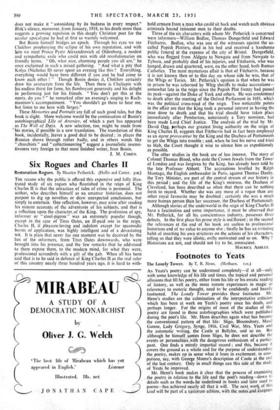Footnotes to Yeats
The Lonely Tower. By T. R. Henn. (Methuen. 2 is.) As Yeats's poetry can be understood completely—if at all—only with some knowledge of his life and times, the topical and personal allusions that fill his poetry, either from his life or his erratic reading of history, as well as the more remote experiences in magic or references to esoteric thought, need to be confidently and heavily footnoted. The Lonely Tower provides these footnotes Mr. Henn's studies are the culmination of the interpretative criticism which has been at work on Yeats's poetry since his death, and perhaps longer. For the origins of most of the studies of this poetry are found in those autobiographies which were published during the poet's life. Mr. Henn describes again what has become the conventional pattern of that life: Sligo, Bloomsbury, Maud Gonne, Lady Gregory, Synge, 1916, Civil War, Mrs. Yeats and the automatic writing, the Castle at Ballylee, and so on. But although he himself comes from Sligo, he does not describe the events or personalities.with the dangerous enthusiasm of a partici- pant. One finds a merely impartial record ; and this, because it covers the ground as a whole and for the purpose of understanding the poetry, makes up in sense what it loses in excitement, in com- parison, say, with George Moore's description of Coole at the end of the last century. Only in small things can this side of the study of Yeats be improved. Mr. Henn's book makes it clear that the process of examining the poetry in relation to the life and the poet's reading—down to details such as the words he underlined in books and later used in poems—has achieved nearly all that it will. The next worl$, of tiln kind will be part of a variorum edition, e ith the noteiand esegeso
underneath the text. The most interesting new material in Mr. Henn's book comes from his rewarding study of the influence of painting on the poetry, and the value of pictures in interpreting scenes in the poetry. Mr. Henn's fine demonstration of the possi- bilities that this subject raises really increase our perception of the poetry. Even by indirect associations he has revealed a new sensuousness in some passages. Even by his conjectures he adds something to our appreciation, as with those well-known lines We dreamed that a great painter had been born To cold Clare rock and Galway rock and thorn,
when he shows that there is a painting by Major Robert Gregory which might have brought to mind that phrase. The one weakness I detect in his case does not concern painting, but is the omission of the more probable debt of Yeats to actual life (the swans at Cook) for " Leda and the Swan."
' Mr. Henn's judgement shows itself in the useful and sensible attention given to " A Vision." Mr. Henn has taken from this heavy and deliberately confusing work what is necessary to under- stand the poetry that derives from it, and has managed to explain the complicated but essential symbols, such as the Gyre, in the most enlightening way, including tfie use of diagrams. He has also explained several of the better and more difficult later poems, like " Byzantium ": and if we sometimes have to look at Yeats to see what Henn means, the very completeness of his analyses must add to our apprehension of the overtones of words and meaning. Without embracing the literary history of Yeats's poetry, which is a different study, this book will probably remain a permanent and valuable source of information for the interested reader as well as for the future scholar. RICHARD MURPHY.



































 Previous page
Previous page